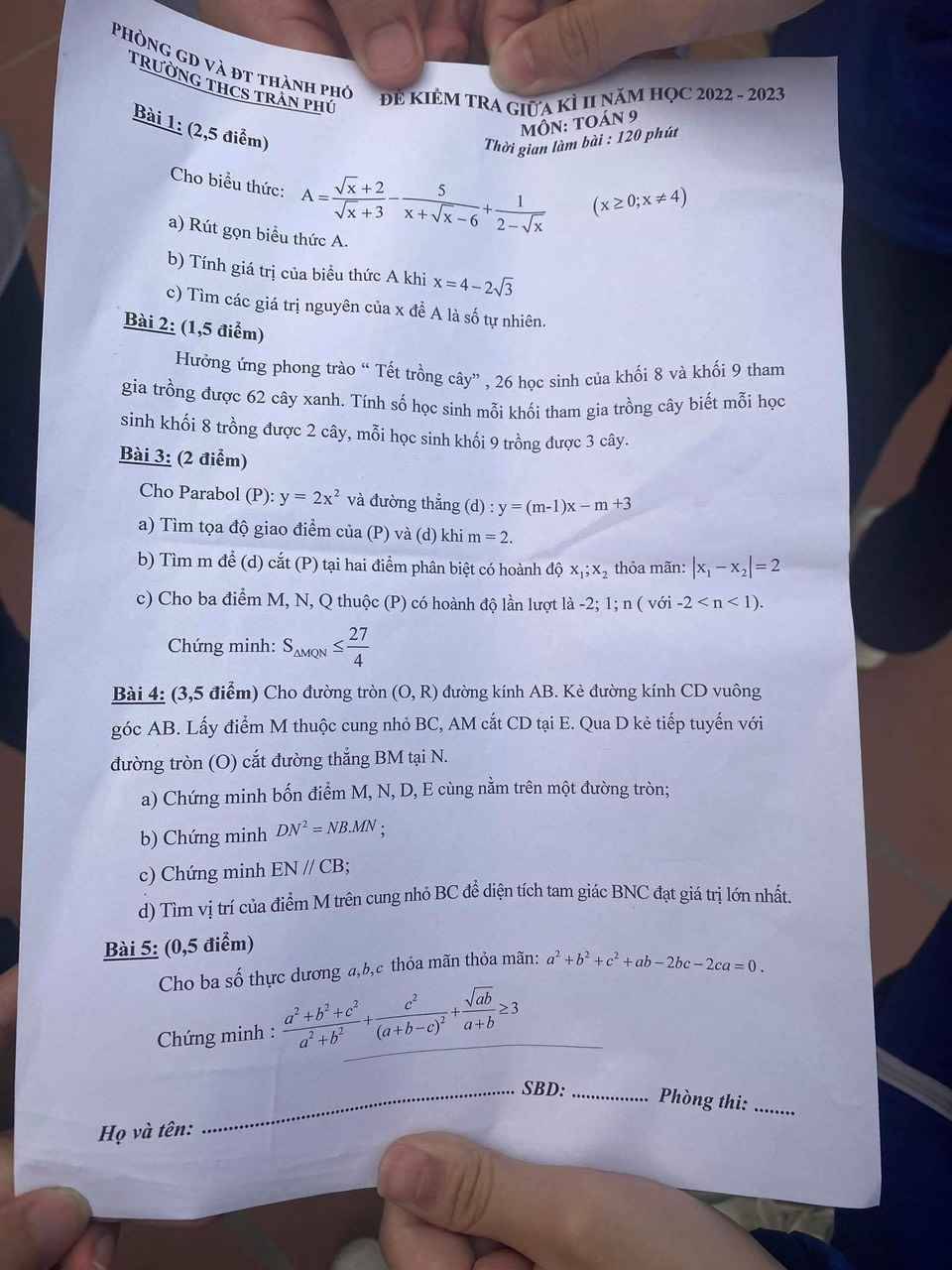Giải hệ phương trình: \(\left\{{}\begin{matrix}x^2-6x+y^2+6y-2xy+9=0\\2x^2+3x+y-\left(3x+1\right)\sqrt{y}-2=0\end{matrix}\right.\)
Hãy nhập câu hỏi của bạn vào đây, nếu là tài khoản VIP, bạn sẽ được ưu tiên trả lời.


Mình không trả lời được, nhưng mình có thể hỏi thử xem mình ra câu này có đúng không nhé.
1.
c, \(A=\dfrac{\sqrt{x}-4}{\sqrt{x}-2}=1+\dfrac{-2}{\sqrt{x}-2}\)
Để A là số tự nhiên \(\Rightarrow\left\{{}\begin{matrix}1+\dfrac{-2}{\sqrt{x}-2}\ge0\\1+\dfrac{-2}{\sqrt{x}-2}\inℤ\end{matrix}\right.\)
\(\Rightarrow\left\{{}\begin{matrix}\dfrac{2}{\sqrt{x}-2}\le1\\\sqrt{x}-2\inƯ\left(-2\right)\end{matrix}\right.\)
\(\Rightarrow\left\{{}\begin{matrix}\dfrac{-\sqrt{x}}{\sqrt{x}-2}\le0\\\sqrt{x}-2\in\left\{\pm1;\pm2\right\}\end{matrix}\right.\)
\(\Rightarrow\left\{{}\begin{matrix}x>4\\x\in\left\{0;1;9;16\right\}\end{matrix}\right.\)
\(\Rightarrow x\in\left\{9;16\right\}\)
Vậy...

Áp dụng BĐT Cauchy cho 3 số thực dương \(xy,yz,zx\), ta có \(xy+yz+zx\ge3\sqrt[3]{\left(xyz\right)^2}\). Do \(xy+yz+zx=3xyz\) nên\(3xyz\ge3\sqrt[3]{\left(xyz\right)^2}\) \(\Leftrightarrow3\sqrt[3]{\left(xyz\right)^2}\left(\sqrt[3]{xyz}-1\right)\ge0\) \(\Leftrightarrow\sqrt[3]{xyz}\ge1\) \(\Leftrightarrow xyz\ge1\)
ĐTXR \(\Leftrightarrow\left\{{}\begin{matrix}xy=yz=zx\\xy+yz+zx=3xyz\end{matrix}\right.\) \(\Leftrightarrow x=y=z=1\)
Ta có \(\dfrac{x}{1+y^2}=\dfrac{x\left(1+y^2\right)-xy^2}{1+y^2}=x-\dfrac{xy^2}{1+y^2}\ge x-\dfrac{xy^2}{2y}\)\(=x-\dfrac{xy}{2}\)
Tương tự, ta có \(\dfrac{y}{1+z^2}\ge y-\dfrac{yz}{2}\) và \(\dfrac{z}{1+x^2}\ge z-\dfrac{zx}{2}\). Từ đó suy ra \(\dfrac{x}{1+y^2}+\dfrac{y}{1+z^2}+\dfrac{z}{1+x^2}\ge x+y+z-\dfrac{xy+yz+zx}{2}\) \(=x+y+z-\dfrac{3}{2}xyz\) . Từ đây suy ra \(Q\ge x+y+z\ge\sqrt[3]{xyz}\ge1\). ĐTXR \(\Leftrightarrow x=y=z=1\).
Vậy GTNN của \(Q\) là \(1\) đạt được khi \(x=y=z=1\)
Dạ thưa thầy, chỗ kia con sửa là \(Q\ge x+y+z\ge3\sqrt[3]{xyz}\ge3\) ạ. GTNN của Q là 3 khi \(x=y=z=1\)

1) -x2 +4x -3=0
=> -x 2 + 3x +x - 3=0
=> - x ( x - 3) + ( x -3 ) =0
=> ( x - 3) ( 1 - x )=0
=> \(\left[{}\begin{matrix}x-3=0\\1-x=0\end{matrix}\right.\Rightarrow\left[{}\begin{matrix}x=3\\x=1\end{matrix}\right.\)

1. Vì (d) cắt trục hoành tại điểm có hoành độ = 2 nên điểm đó có tọa độ (2;0) => x = 2; y = 0
Thay x = 2; y = 0 vào (d) ta có: 0 = (2 - m).2 + m + 1
<=> 4 - 2m + m + 1 = 0 <=> 5 - m = 0 <=> m = 5
Vậy m = 5 thì thỏa mãn
2. \(\left\{{}\begin{matrix}3x+2y=11\\x-2y=1\end{matrix}\right.\)
<=>\(\left\{{}\begin{matrix}4x=12\\x-2y=1\end{matrix}\right.\)
<=>\(\left\{{}\begin{matrix}x=3\\3-2y=1\end{matrix}\right.\)
<=>\(\left\{{}\begin{matrix}x=3\\y=1\end{matrix}\right.\)
Vậy hệ phương trình có nghiệm (x;y)=(3;1)


Điều kiện: \(y\ge0\)
pt thứ nhất của hệ \(\Leftrightarrow\left(y-x+3\right)^2=0\) \(\Leftrightarrow y-x+3=0\) \(\Leftrightarrow y=x-3\)
Thay vào pt thứ hai của hệ, ta được \(2x^2+3x+x-3-\left(3x+1\right)\sqrt{x-3}-2=0\)
\(\Leftrightarrow2x^2+4x-5=\left(3x+1\right)\sqrt{x-3}\) \(\left(x\ge3\right)\)
\(\Rightarrow\left(2x^2+4x-5\right)^2=\left[\left(3x+1\right)\sqrt{x-3}\right]^2\)
\(\Leftrightarrow4x^4+16x^2+25+16x^3-20x^2-40x=\left(3x+1\right)^2\left(x-3\right)\)
\(\Leftrightarrow4x^4+16x^3-4x^2-40x+25=9x^3-21x^2-17x-3\)
\(\Leftrightarrow4x^4+7x^3+17x^2-23x+28=0\)
Đặt \(f\left(x\right)=4x^4+7x^3+17x^2-23x+28\)
\(f\left(x\right)=4x^4+7x^3+17x^2+4+4+...+4-23x+4\) (có 6 số 4 ở giữa)
\(f\left(x\right)\ge9\sqrt[9]{4x^4.7x^3.17x^2.4^6}-23x+4\) \(=\left(9\sqrt[9]{1949696}-23\right)x+4\)
Hiển nhiên \(9\sqrt[9]{1949696}>23\). Lại có \(x\ge3\) nên \(f\left(x\right)>0\), Như vậy pt \(f\left(x\right)=0\) vô nghiệm. Điều đó có nghĩa là phương trình đã cho vô nghiệm.